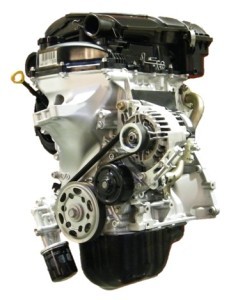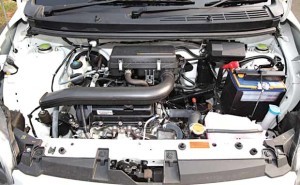
Engines 1KR-FE, 1KR-DE, 1KR-DE2
 Toyota 1KR series engines belong to the class of low-power compact 3-cylinder units. They are developed by a subsidiary of Toyota Corporation - Daihatsu Motor Co. The flagship of the series is the 1KR-FE engine, which was first introduced in November 2004 on the new Daihatsu Sirion for the European market.
Toyota 1KR series engines belong to the class of low-power compact 3-cylinder units. They are developed by a subsidiary of Toyota Corporation - Daihatsu Motor Co. The flagship of the series is the 1KR-FE engine, which was first introduced in November 2004 on the new Daihatsu Sirion for the European market.
The practical experience of operating the Sirion hatchback in Europe very quickly showed car specialists around the world that Daihatsu engineers managed to create a great engine specifically for small city cars. The main advantages of this internal combustion engine are low weight, efficiency, good traction in a wide range of low and medium speeds, as well as a minimum level of harmful emissions. Thanks to these qualities, in subsequent years, the 1KR engine thoroughly and widely settled not only under the hoods of small cars "native" Daihatsu and Toyota, but also began to be successfully used in compact cars from third-party manufacturers such as Citroen-Peugeot and Subaru.
The design features of the Toyota 1KR-FE engine are as follows:
- All major engine parts (cylinder head, BC and oil pan) are made of light aluminum alloy, which provides the unit with excellent weight and dimensions, as well as a low level of vibration and noise;
- Long-stroke connecting rods, coupled with the VVT-i system and the intake duct geometry optimization system, allow the engine to develop a fairly high torque over a wide rev range;
- Pistons and piston rings of the engine are coated with a special wear-resistant composition, which significantly reduces power losses due to friction;
- Compact combustion chambers provide optimal conditions for the ignition of the fuel mixture, which leads to a reduction in harmful emissions.
That's interesting. ICE 1KR-FE four years in a row (2007-2010) became the winner of the international award "Engine of the Year" (in English spelling - International engine of the Year) in the category of 1 liter engines, which was established and annually awarded by the UKIP Media & Events Automotive Magazines organization according to the results of voting by journalists from leading automotive publications.
Technical specifications
| Parameter | Value |
|---|---|
| Manufacturing company / factory | Daihatsu Motor Corporation / March plant |
| Model and type of internal combustion engine | 1KR-FE, petrol |
| Years of issue | 2004-NV. |
| Configuration and number of cylinders | Inline three-cylinder (R3) |
| Working volume, cm3 | 996 |
| Bore / Stroke, mm | 71,0 / 84,0 |
| Compression ratio | 10,5:1 |
| Number of valves per cylinder | 4 (2 inlet and 2 outlet) |
| Gas distribution mechanism | Single row chain, DOHC, VVTi system |
| Max. power, hp / rpm | 67/6000 (71/6000*) |
| Max. torque, N m / rpm | 91/4800 (94/3600*) |
| Fuel system | EFI - distributed electronic injection |
| Ignition system | Separate ignition coil per cylinder (DIS-3) |
| Lubrication system | Combined |
| Cooling system | Liquid |
| Recommended octane number of gasoline | Unleaded gasoline AI-95 |
| Approximate fuel consumption in the urban cycle, l per 100 km | 5-5,5 |
| Environmental standards | EURO 4 / EURO 5 |
| Material for the manufacture of BC and cylinder head | Aluminium alloy |
| Weight of internal combustion engine with attachments (approximate), kg | 69 |
| Engine resource (approximate), thousand km | 200-250 |
* - specific parameter values depend on the settings of the engine control unit.
Applicability
Below is a complete list of cars from different manufacturers on which the 1KR-FE ICE has been installed and is being installed so far:
- Toyota Passo (05.2004-present);
- Toyota Aygo (02.2005- present);
- Toyota Vitz (01.2005-present);
- Toyota Yaris (08.2005-present);
- Toyota Belta (11.2005-06.2012);
- Toyota iQ (11.2008-present);
- Daihatsu Sirion;
- Daihatsu Boon;
- Daihatsu Cuore;
- Subaru Justy;
- Citroen C1;
- Peugeot 107.
Engine modifications
 Especially for the Asian automotive markets, Toyota developed two simplified versions of the 1KR-FE engine on the 1KR-FE engine platform: 1KR-DE and 2KR-DEXNUMX.
Especially for the Asian automotive markets, Toyota developed two simplified versions of the 1KR-FE engine on the 1KR-FE engine platform: 1KR-DE and 2KR-DEXNUMX.
Production of the 1KR-DE ICE began in 2012 in Indonesia. This power unit was intended to equip the Toyota Aqva and Daihatsu Ayla urban compacts manufactured by the Astra Daihatsu joint venture and supplied to the local market as part of the Low Cost Green Car program. The 1KR-DE engine is distinguished from its “parent” by the absence of the VVT-i system, as a result of which its characteristics have become “modest”: maximum power is 48 kW (65 hp) at 6000 rpm, torque is 85 Nm at 3600 rpm . The diameter and stroke of the pistons remained the same (71 mm by 84 mm), but the volume of the combustion chamber increased slightly - up to 998 cubic meters. cm.
Instead of aluminum, heat-resistant rubber-plastic was chosen as the material for the manufacture of the 1KR-DE cylinder head, which made it possible to reduce the total weight of the engine by almost 10 kg. For the same purpose, an exhaust manifold and a catalytic converter with an oxygen sensor were integrated into a single construct with the cylinder head.
In 2014, in Malaysia, at a joint venture with Daihatsu, the production of the Perodua Axia hatchback began, on which they began to install a more powerful version of the 1KR-DE engine - 1KR-DE2. The increase in power was achieved by slightly increasing the compression ratio of the working mixture - up to 11:1. The 1KR-DE2 produces a maximum of 49 kW (66 hp) at 6000 rpm and 90 Nm at 3600 rpm. Other characteristics are completely similar to those of the 1KR-DE engine. The motor meets the environmental requirements of EURO 4, and to achieve a higher standard, it clearly lacks the VVT-i system.
It should be noted that the 1KR-DE2 ICE produced in Malaysia is used on another Toyota model. This is a Toyota Wigo car, which is assembled by a subsidiary of a Japanese corporation and supplied to the Philippine automotive market.
The Chinese, based on the 1KR-FE engine, developed and created their own similar three-cylinder internal combustion engine with the BYD371QA index.
Service recommendations
The Toyota 1KR engine is a complex modern power unit, so its maintenance issues come to the fore. A prerequisite for maintaining the resource built into the engine by the manufacturer is the timely replacement of engine oil, filters and spark plugs. Use only high quality 0W30-5W30 SL/GF-3 engine oil. Failure to comply with this requirement can lead to clogging of the valves of the VVT-i system and further failure of the engine as a whole.
Like most other ICEs made from light alloys, the 1KR-FE is a “disposable” engine, which means that if its internal parts and surfaces are damaged, it is almost impossible to repair them. Therefore, any extraneous knock inside the engine should be a signal for the owner to establish the cause of its occurrence and promptly eliminate the identified defect. The weakest link in the internal combustion engine is the timing chain. Contrary to popular belief that the circuit practically does not fail, the resource of this device is much less than the total resource of the internal combustion engine. Replacing the timing chain with a 1KR-FE after 150-200 thousand kilometers is quite common.
According to the reviews of the owners, the repair of the 1KR-FE engine most often involves the repair of attachments or electronic devices and systems that make up the motor. Problems appear mainly in age-related products and they are associated, for the most part, with clogging of the VVT-i valves and throttle.
Additional fame for the 1KR-FE engine was brought by snowmobile owners who are happy to purchase contract engines of this model and install them in place of factory units. A striking representative of such tuning is the Taiga snowmobile with a 1KR engine.


One comment
Jean Paul Kimenkinda.
I followed the presentation of the different engines which are interesting, I managed to overhaul a 1KR-FE engine by modifying the turn of the 3 connecting rods, by making the joint where the wedge part of the connecting rod bearing will be housed on the one hand . On the other hand, I enlarged the oil hole of the oil tensioner piston.